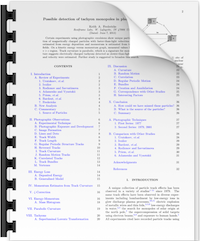downloads
2013: Possible detection of tachyon monopoles in photographic emulsions
Certain experiments using photographic emulsions show unique particle tracks suggesting detection of magnetically charged particles with faster-than-light velocities. Particle kinetic energy is estimated from energy deposition and momentum is estimated from track curvature in magnetic fields. On a kinetic energy versus momentum graph, measured values for sample tracks fall in the v > c region. Track curvature is parabolic, which is a signature for monopoles. The plane of curva- ture suggests electrically charged tachyons detected as slower-than-light monopoles. Particle mass and velocity were estimated. Further study is suggested to broaden this search.
2013: Possibility of tachyon monopoles detected in photographic emulsions
Low-energy nuclear reaction experiments using photographic emulsions, including those by Urutskoev, et.al, Ivoilov, and others have shown unique particle tracks. Analysis of a sample population of these types of tracks suggests detection of magnetically charged particles with faster-than-light velocities. Particle kinetic energy was estimated from energy deposition and momentum was esti- mated from track curvature in magnetic fields. Measured values were plotted on a kinetic energy versus momentum graph and were found to fall in the v > c region. Track curvature was found to be parabolic, which is a signature for monopoles. Using the classical theory of tachyons, the plane of parabolic curvature suggests electrically charged tachyons detected as slower-than-light monopoles. Preliminary lower limits for particle mass are found. Further study is suggested to broaden this search.
2016: Magnetic monopole mass from fundamental lengths
With an assumption of n = 2 in the Dirac quantization condition, when the sequence comprised of the Bohr radius, reduced Compton wave- length and classical electron radius is extended and matched with its velocity sequence, these fundamental lengths are mirrored with a corresponding set of fundamental monopole lengths with the speed of light as the axis of symmetry. Monopole charge is g = 137ec and mass is found to be 1.45×10−3 eV/c2. This result may fit with the extended relativity (tachyon) theory of Recami with a modification of the proposed charge quantization and electromagnetic coupling constant.


